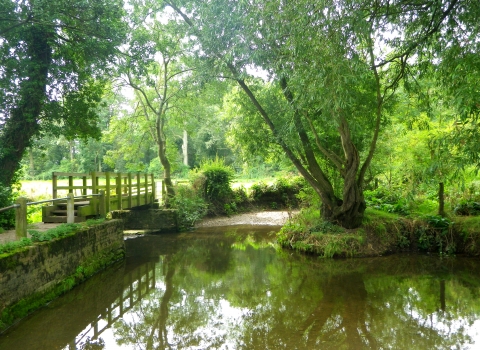The Bow Brook
The Bow Brook is a Local Wildlife Site of at least county importance for its wildlife. It stretches from Redditch in the north to the village of Defford, near Pershore, in the south. It flows through and near many small towns and villages including the villages of Feckehnam, Hanbury, Crowle, Peopleton and Drakes Broughton. The Bow Brook catchment forms part of the historic ‘Forest of Feckenham’, which was once used as a royal hunting ground.
The Bow Brook Project was a pilot scheme for Worcestershire Wildlife Trust. For the first time we worked with partners and landowners on a catchment scale to develop an effective, efficient and robust approach that could be rolled out across Worcestershire watercourses.
Why is the Brook so important?
The brook corridor, as well as being home to wildlife itself, acts as a pathway for migrating and dispersing species such as wading birds and otters, connecting up larger areas of potential habitat. As part of our work we focused on reconnecting remaining quality habitats including wetlands, grasslands and hedgerows. Here we worked alongside and engaged with communities, landowners and farmers across the whole catchment to increase not only the quality of the existing habitat but also the brook's potential as a corridor for wildlife connectivity.
What was the problem?
The catchment has lost many of its associated habitats and historical features such as traditional meadows; many old ponds and wet fields that would have been home to rare plants and animals have been lost through drainage. In some places the watercourse has become overgrown with in-channel vegetation and bankside cover; elsewhere it has higher than expected levels of pollutants and chemicals from roads, gullies and land drainage. In other parts of the catchment, however, there are still valuable wildlife areas including some our own nature reserves, well managed permanent pastures, small wetlands and Sites of Special Scientific Interest.
Sadly, and in common with many watercourses across the country, the brook's wildlife has declined in the past 50 years through increased drainage, agricultural improvements and urbanisation. Widening and deepening of the brook along with increased inputs from the land (road silts / soils / pesticides / oils / fertilisers / sewage) have resulted in unnatural river characteristics both physically and biologically.
What have we done?
In 2011 we partnered with The Environment Agency (EA) to help them to meet targets for the Water Framework Directive (WFD). This directive is a piece of European Legislation that requires the EA to deliver 'good ecological condition’ on watercourses by 2027. On the Bow Brook that means reducing pollutants, improving water quality and delivering direct habitat enhancements to provide more space for wildlife.
The Environment Agency provided funding to the Wildlife Trust to facilitate projects that delivered improvements to the water quality and ecology of the brook to improve conditions for invertebrates and fish populations. This funding allowed us to extend our work beyond the areas covered by agri-environment schemes and towards landowners who did not qualify for or wish to join these schemes.
By the end of 2012 we had completed a series of works across the catchment, principally focussed in three areas around the villages of Huddington, Peopleton and Drakes Broughton. We visited more than 20 sites and gave advice to their owners, reverted more than 2.5ha of arable land to grassland (to reduce silt runoff), created more than 8000m2 of ponds and scrapes and enhanced over 1600m of waterside habitat for wildlife.
The project won an England River Prize in 2014.

